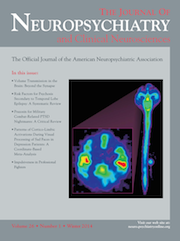To the Editor: Catatonia may often present with puzzling symptoms and etiologies that can delay adequate and timely treatment, increasing the risk of mortality.
1 When accompanied with hyperthermia and autonomic instability, it is called malignant catatonia (MC).
1,2 When preceded by antipsychotic use, catatonia is usually termed and treated as neuroleptic malignant syndrome (NMS), which is regarded as a variant of MC.
1,3 The case below inspired us to highlight the challenges in diagnosing and adequately treating MC and its fatal consequences.
An 82-year-old man with Bipolar-I disorder (BD) consulted in the Neurology-ICU for failure to respond to an adequate trial of bromocriptine
3,4 (7.5 mg/day for 20 days) administered as a hospital practice, depending on the provisional diagnosis of olanzapine-induced NMS. Reportedly, he was taken to ER and then transferred to the Neurology-ICU with acute-onset insomnia, fever (38.5°C), excessive sweating, hypertension (140/90 mmHg), tachycardia (105 bpm), diffuse rigidity, elevated serum-CPK, and delirium state marked by fluctuating consciousness and lying naked on the floor with extreme resistance to being moved. Head injury, metabolic disorders, seizures, infections, and intoxication were all excluded with comprehensive history and labs. His BD was in remission for 6 months with valproate sodium 1,000 mg/day and olanzapine 5 mg/day. However, he had discontinued both medications 1 week before admission. Clinical history and bedside examination that revealed diffuse rigidity and immobility associated with disturbances in thought, mood, and vigilance suggested catatonia, and accompanying hyperthermia and autonomic instability suggested MC.
1,2 The retarded/stuporous variant of catatonia was predominant throughout the entire hospital stay, although he sometimes displayed several signs of the excited form, as reported.
2 We reformulated the phenomena by considering the following diagnostic elements: First, discontinuation of olanzapine 1 week before admission would significantly reduce the possibility of NMS,
1 which should have been considered at intake. Second, he failed to respond to an adequate trial of bromocriptine,
3,4 a specific treatment for NMS. Therefore, on the 21st day of MC, we initiated lorazepam 5 mg/day and increased it to 12.5 within a few days. We preferred lorazepam because of its ease of administration, wide margin of safety,
3 fast response,
2,3 the absence of cardiovascular challenge even at high doses, unlike ECT,
2,3 the fact that there is no need for anesthesia, and that it is less stigmatizing than ECT. We maintained an adequate trial of lorazepam
1,3,5 for 28 days, with little improvement in catatonia. We decided to administer ECT for its efficacy in relieving MC where benzodiazepines have failed (a response rate of 89% to ECT, 40% to benzodiazepines),
2 but we could not. The patient died of aspiration pneumonia developed during stuporous exhaustion.
We took several lessons from this case. Hierarchy of treatment selection in catatonia should consider all variants and etiologies. Although benzodiazepines and ECT can treat both malignant and non-malignant catatonia, bromocriptine is peculiar to NMS, that is, neuroleptic-induced MC.
3 To satisfy all needs with one deed, ECT can be the first-choice treatment in life-threatening catatonic states due to restriction of oral intake,
5 having breached the malignancy threshold,
1,2 and long duration of catatonia that predicts poor response to benzodiazepines,
5 and that it can quickly relieve catatonia, accompanying delirium, and the underlying psychiatric disorder.
4
